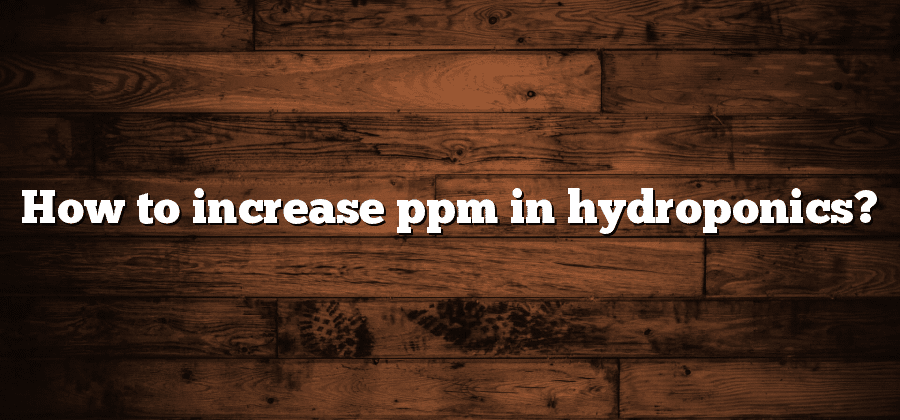Understanding PPM in Hydroponics
Part 1:
In hydroponics, PPM, or parts per million, is a measurement used to quantify the strength of nutrient solutions. It refers to the number of dissolved solids, such as minerals and nutrients, in the water used to nourish the plants. Understanding PPM is essential for hydroponic growers as it provides valuable insights into the nutrient levels and overall health of the plants.
PPM can be measured using an electrical conductivity (EC) meter, which calculates the electrical conductivity of the solution. The higher the PPM, the more concentrated the nutrient solution. This measurement is crucial because it helps growers ensure that their plants are receiving the necessary nutrients for healthy growth. Additionally, monitoring PPM levels allows growers to identify and address any nutrient imbalances or deficiencies that may be hindering plant development. To achieve optimal PPM levels, growers must consider various factors that can influence them, such as the type of plants being cultivated, water quality, and the specific nutrient solution used.
Factors Affecting PPM Levels in Hydroponics
Accurately monitoring and maintaining the ideal PPM (parts per million) levels in hydroponics is crucial for the overall success of any hydroponic system. In order to achieve optimal PPM levels, it is important to understand the various factors that can influence these levels.
One of the key factors that can affect PPM levels in hydroponics is the type and composition of the nutrient solution being used. Different plants have different nutrient requirements, and it is essential to choose the right nutrient solution that matches the specific needs of the plants being grown. By providing the plants with the necessary nutrients in the correct proportions, you can ensure that the PPM levels remain within the desired range for healthy growth. Additionally, it is important to consider the quality of the water being used to prepare the nutrient solution, as impurities or high mineral content in the water can contribute to elevated PPM levels. Regularly testing the water and making any necessary adjustments can help to maintain optimal PPM levels in hydroponics.
Choosing the Right Nutrient Solution for Higher PPM
To achieve higher parts per million (PPM) levels in hydroponics, choosing the right nutrient solution is crucial. The nutrient solution serves as the primary source of essential elements for plants, and each plant has specific requirements that need to be met. When selecting a nutrient solution, it is essential to consider the different stages of plant growth and their nutrient needs. Nutrient solutions are typically labeled based on the specific requirements of plants during the vegetative or flowering stages.
When choosing a nutrient solution for higher PPM levels, it is important to look for a solution that provides a balanced ratio of macro and micronutrients. Macronutrients such as nitrogen, phosphorus, and potassium are required in larger quantities, while micronutrients such as iron, manganese, and zinc are needed in smaller amounts. It is essential to read the labels carefully and ensure that the nutrient solution contains the necessary elements in the correct proportions. Additionally, opting for a nutrient solution with high-quality ingredients will ensure better nutrient uptake and overall plant health. By selecting the right nutrient solution, growers can provide their plants with the necessary nutrients for achieving higher PPM levels and optimal growth.
Balancing pH Levels for Optimal PPM
Maintaining the ideal pH levels is crucial in achieving optimal PPM (parts per million) in hydroponics. The pH scale ranges from 0 to 14, with 7 being considered neutral. In hydroponics, it is recommended to maintain pH levels between 5.5 and 6.5 for most plant varieties.
When pH levels are too high or too low, nutrient deficiencies can occur, limiting the plant’s ability to absorb essential minerals and affecting overall growth and productivity. To ensure balanced pH levels, it is important to regularly test the nutrient solution using a pH tester. Adjustments can then be made by adding pH up or pH down solutions in small increments to bring the pH into the desired range. By maintaining the proper pH levels, plants are able to effectively uptake the necessary nutrients, which in turn leads to higher PPM and healthier growth in hydroponics systems.
Monitoring and Adjusting Nutrient Strength for Increased PPM
Proper monitoring and adjusting of nutrient strength is essential in hydroponics to achieve increased parts per million (PPM) levels. As PPM represents the concentration of dissolved nutrients in the nutrient solution, it directly affects the growth and development of plants. To ensure optimal PPM levels, it is crucial to regularly monitor the nutrient strength using a PPM meter.
The first step in monitoring and adjusting nutrient strength is to take initial measurements. This involves measuring the PPM level of the nutrient solution before it is provided to the plants. By establishing a baseline PPM level, growers can identify any discrepancies and make necessary adjustments. Regular monitoring allows growers to stay on top of any fluctuations in PPM levels and respond promptly to maintain an optimal balance of nutrients. Adjustments can be made by adding or diluting the nutrient solution to achieve the desired PPM level, ensuring that plants receive the necessary nutrients for healthy growth.






